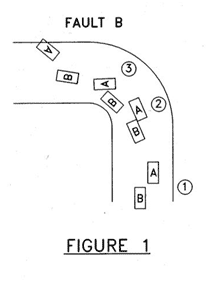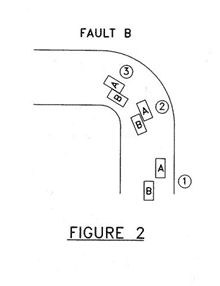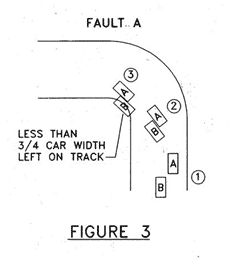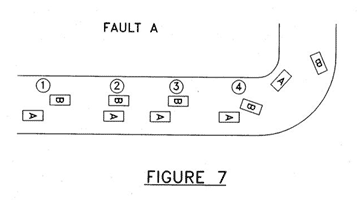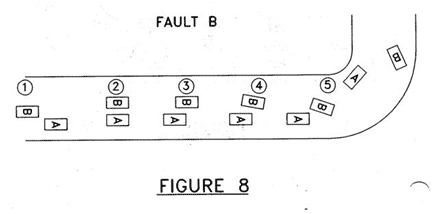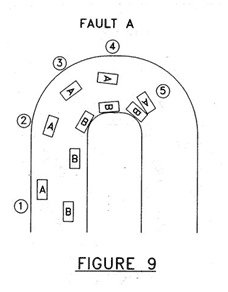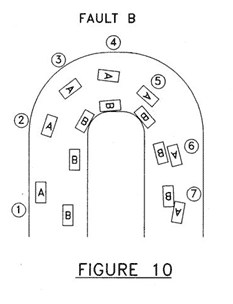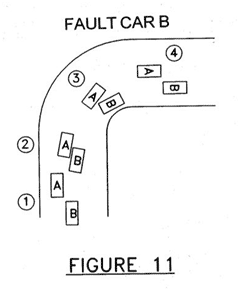MSF RACING SPORTING REGULATIONS SECTION 16: DRIVING STANDARDS & ON COURSE CONDUCT
CODE & GUIDELINES TO DRIVING DISCIPLINE & OVERTAKING
INTRODUCTION TO SECTION 16
Objective: to provide a structure for Drivers and Race Control together with the Clerk Of The Course for race driving discipline and conduct at MSF Racing events.
The Clerk Of The Course (COC), Race Stewards, and Race Control will take these guidelines into account when assessing a Official Protest and/or Complaint against another competitor’s sporting and driving conduct during the event, whether it is a report from a Marshal or from another competitor. THESE GUIDELINES ARE ENFORCEABLE.
16. DRIVING STANDARDS & ON COURSE CONDUCT
16.1 On Course Conduct – Detailed
16.1.1 Racing Room
Drivers must respect the right of other competitors to “racing room”. Drivers are responsible to avoid physical contact between cars on the race track.
Each competitor has a right to “racing room”, which is generally defined as “at least three quarters of one car width”, or “sufficient space on the racing surface that under racing conditions, a driver can maintain control of his car in close quarters”.
Abrupt changes in direction that impede or affect the path of another car attempting to overtake or pass may be interpreted as an effort to deprive a fellow competitor of the right to racing room.
16.1.2 Rough, Careless, and Irresponsible Driving
Any driver, deemed by the Clerk of the Course (COC), displaying rough, careless, and/or irresponsible driving may be penalised. The COC shall determine the course of action.
16.1.3 Rules for Overtaking
Passing General
The responsibility for the decision to pass another car, and to do it safely, rests with the overtaking driver. The overtaken driver should be aware that he/she is being passed and must not impede the pass by blocking. A driver who does not watch his/her mirrors or who appears to be blocking another car seeking a pass may be penalised. The act of passing is initiated when the trailing car’s (Car A) front bumper overlaps with the lead car’s (Car B) rear bumper. The act of passing is complete when Car A’s rear bumper is ahead of Car B’s front bumper.
Punting
The term “punting” is defined as nose to tail (or side-of-the-nose to side- of- the-tail) contact, where the leading car is significantly knocked off of the racing line. Once the trailing car has its nose next to the driver of the other vehicle, it is considered that the trailing car has a right to be there. And, that the leading driver must leave the trailing driver enough “racing room.” In most cases, “racing room” is defined as “at least three quarters of one car width.” If adequate racing room is left for the trailing car, and there is incidental contact made between the cars, the contact will be considered “side-to-side.” In most cases, incidental side-to- side contact is considered to be “just a racing incident.” If, in the case of side-to-side contact, one of the two cars leaves the racing surface (involuntarily) then it may still be considered “a racing incident.”
Right to the Line
The driver in front has the right to choose any line, as long as they are not considered to be blocking. The driver in front loses the right to choose his or her line when the overtaking driver has their front wheel next to the driver. Note: This rule may be superseded by class specific rules.
Blocking
A driver may choose to protect his or her line so long as it is not considered blocking. Blocking is defined as two (2) consecutive line changes to “protect his / her line,” and in doing so, impedes the vehicle that is trying to pass with each of the two (2) consecutive movements. Drivers are encouraged to check with the COC for a full explanation before the start of the race.
16.1.4 Yellow Flag- Passing
A pass must be completed before the yellow flag station. This means that the overtaking driver must be completely in front of the overtaken car before either vehicle breaks the plane perpendicular to the track as defined by the yellow flag. Note: Drivers that attempt to “race to the yellow” to complete a pass may enter the yellow zone too fast and not under full control; and therefore be penalised for failing to comply with the conditions of the appropriate yellow flag rules.
16.1.5 Off-course Excursions
The competitor is required to follow the marked course during competition and shall not gain an advantage by an off-course excursion. An off-course excursion is defined as leaving the marked course with all four wheels. The definition of the term “advantage gained” will be left up to the sole discretion of the COC, and may include pass attempts that were completed, but the overtaking driver went four-wheels-off on the exit, and it was deemed to be an otherwise “ill -fated” pass. Penalties may be assessed for an off-course excursion that affords an advantage to the offender. Those that have gone off course have a duty to reenter the course safely and give right of way to those vehicles that are on track. Reentry should be at the point that the vehicle left course, or at another location, providing that no advantage has been gained by doing so.
It is the responsibility of the driver reentering the course to yield and stay offline until back up to traffic speed. In the case of reentering the track in the middle of the pack, during a full course yellow, the driver will yield and stay offline until they match the speed of the traffic, in which case they shall merge in. While drivers may pass a reentering vehicle under full course yellow or a vehicle that is getting up to speed under full course yellow, they must not impeded the reentering vehicle while attempting to merge at traffic speeds.
16.1.6 Post Accident Reporting
All persons involved in any “Significant Accidents” are REQUIRED to report to the medical staff immediately. Failure to do so WILL result in suspension. “Significant Accidents” are:
- All vehicle roll-overs, regardless of damage.
- Heavy impact rendering the vehicle inoperable.
16.1.7 Driving in the other direction of the course
Participants shall not drive on the course in the direction opposite to the normal traffic flow, unless a driver must do so for a short distance, in an extreme emergency and only for the sole purposes of getting out of harm’s way, or when ordered to do so by a Marshal.
16.1.8 Stopping On Course
Stopping on course is expressly prohibited unless it is an emergency event. “Stopping” includes abrupt and/or unexpected slowing to a near stop. Stopping to help a disabled car is prohibited. An emergency, for the purposes of this section, is defined as only those events concerning medical problems, mechanical failure, on-board fire, or damage from an incident that renders the vehicle unfit to continue
16.1.9 Stopping in an Emergency
Anytime a driver is forced to stop in an emergency; the first concern should be to place the car in an area where it will not cause danger to the other drivers. When stopping off course, the driver should be careful not to stop on dry grass areas where fire can be a hazard. The crew may come to the aid of a disabled car only with the approval of the COC. The driver may make repairs if the vehicle is in a safe area, such as behind a wall or flag stand.
16.1.10 Crashes
If a driver is involved in a major crash or roll-over, the driver may exit the vehicle if it is safe to do so. The driver is responsible for determining if and when he/she should exit the vehicle. Once clear of the vehicle the driver will wait in a safe area away from the track surface and impact zones until the Emergency Response Team arrives. A driver that has exited the car may NOT walk back to the paddock Also see section #16.1.6.
16.1.11 Heating of Tires
Weaving to heat tires (a.k.a. scrubbing) is prohibited on track, except under full-course yellow / Safety Car conditions; and only when prudent to do so. Weaving to heat tires (a.k.a. scrubbing) is prohibited in the pitlane at all times.
16.2 Clarification, Examples, and Penalties.
The purpose of this section is to review and clarify the rules of the road as applied to MSF Racing Series. THE FOLLOWING ARE EXCERPTS FROM SECTION 16.1 ON COURSE CONDUCT – DETAILED.
Third party video MAY BE considered as evidence during investigation for Dangerous Driving and / or circuit misbehaviour / misdemeanours.
EXTRACT:
16.1.2 Rough, Careless, and Irresponsible Driving
Any driver, deemed by the COC, displaying rough driving may be penalised. The COC shall determine the course of action.
16.1.3 Punting
The term “punting” is defined as nose to tail (or side-of-the-nose to side- of- the-tail) contact, where the leading car is significantly knocked off of the racing line. Once the trailing car has its nose next to the driver of the other, it is considered that the trailing car has a right to be there. And, that the leading driver must leave the trailing driver enough “racing room.” In most cases, “racing room” is defined as “at least three quarters of one car width.” If adequate racing room is left for the trailing car, and there is incidental contact made between the cars, the contact will be considered “side -to-side.” In most cases, incidental side-to-side contact is considered to be “just a racing incident.” If, in the case of side-to-side contact, one of the two cars leaves the racing surface (involuntarily) then it may still be considered “a racing incident.” [Note: The whole intent of the “nose next to the driver” rule is to make sure that the overtaken driver sees the overtaking car.]
EXPLANATION:
These two rules are the basis by which the COC will determine fault when two (2) or more cars are involved in an on-track incident. The rules described in the Sporting Regulations ASR section #16.1.3 are intended to help drivers determine when they should attempt a pass, and who may be at fault should there be an incident. The main purpose of the “¾ car width” rule is not to allow one driver to “squeeze” the other driver. The main purpose and intent is to alert the mind of the driver that is contemplating a pass that he/she may be “forced” to go two (2) wheels off- course to avoid a collision. Basically, this means that the overtaking driver must be certain that he / she can attempt the pass with room to spare, and must be prepared to take evasive action if necessary.
Note to drivers: Remember that, even though you have the “right of way” it may not be smart to insist upon it. You may be involved in a collision that was not your fault, but you may end up crashing your car, sustain damage, get hurt, or at the very least be punted out of the race. The other driver may get penalties, but that will not help you fix your car, get your position back, or get you out of the hospital any faster.
DESCRIPTION OF ON-TRACK INCIDENTS:
Figure 1
Car B is attempting to pass Car A going into a left-hand corner. There is contact between the two cars at point 2. At the point of contact Car B does not have its front wheel next to the driver of Car A, and therefore does not have a right to be there. Therefore the fault is placed on Car B.
Figure 2
Car B is attempting to pass Car A going into a left-hand corner. There is contact between the two cars at point 3. Car B does have its front wheel next to the driver of Car A and therefore does have a right to be there. However, Car A leaves Car B more than enough room to make the pass. Car B has an obligation to make the pass without contact. Therefore the fault is placed on Car B.
Figure 3
Car B is attempting to pass Car A going into a left-hand corner. There is contact between the two cars at point 3. Car B does have its front wheel next to the driver of Car A and therefore does have a right to be there. However, Car A does not leave Car B more than enough room to make the pass. In this case, “more than enough room” is defined as “at least ¾ of one car width.” Therefore the fault is placed on Car A.
Figure 4
Car B is attempting to pass Car A going into a left-hand corner. There is contact between the two cars at point 3. Car B does have its front wheel next to the driver of Car A and therefore does have a right to be there. However, Car A leaves Car B less than one car width but more than ¾ of one car width. The driver of Car B should not have attempted to make that pass if he/she was not willing to drive into the dirt to avoid collision. The driver of Car B is at fault, however he/she should report the incident to the COC. The COC should talk to the driver of Car A for not watching his/her mirrors, as well as the driver of Car B for being at fault in the incident.
Figure 5
This is the same incident that occurred in Figure 4, however Car A is at fault for not leaving enough racing room. In most cases, ¾ of one car width would be considered barely adequate racing room. However, in this case there is “K-wall’ to the inside of the corner. Common sense would tell the driver of Car A that there would definitely be a collision if less than one full car width were left for Car B.
Figure 6
Car B is attempting to pass Car A going into a left-hand corner. There is contact between the two cars at point 3. Car A has already turned in and is committed to the corner. Car B attempts a last minute pass (dive bomb) and ends up locking up all four wheels and sliding into the side of Car A. This is a collision resulting from poor judgment and overly-aggressive driving on the part of the driver of Car B.
Figure 7
Car A is attempting a pass on a long straight leading to a left-hand turn. At point 2, Car A pulls alongside Car B and has a right to be there. However, by point 3 Car A falls back, where his/her front wheel is no longer alongside the driver of Car B. At point 3, Car B begins to move to the right and Car A refuses to relinquish the attempted pass. There is contact at point 4. Car A is at fault even though technically Car B hit Car A. Car A did not have his/her front wheels up even with the driver of Car B, and thus did not have a right to be there. Car B has the right to choose the line, and Car A must back out of it. Note: Car B may not be at fault in this situation, and the driver of Car A may be penalised, but Car B is still knocked out of the race. Remember that, even though you have the “right of way” it may not be smart to insist upon it.
Figure 8
This is the opposite situation from Figure 7. Although the outcome is the same, the fault is reversed. Car B is attempting to make a pass. After point 4, one might assume that Car B has the right to choose his/her line as per the rules and that would mean that Car A must back out of it. However, the fault still lies with Car B. This is where things get tricky. There are two different rules that govern this situation, and it is up to the COC to make a determination. The first rule states that Car B has a right to choose any line because Car A no longer has a wheel next to the driver of Car B. Therefore, Car A must relinquish the lead. However, there is another rule that says that the driver that is attempting to make a pass has the responsibility to complete that pass safely. In this case the overriding rule would be the latter. That is why Car B would be at fault. Car B failed to complete a safe pass. The whole intent of the “wheel next to the door” rule is to make sure that the overtaken driver sees the overtaking car. Well in this case, the driver of Car B clearly knew that Car A was there because he/she was the one making the pass.
Figure 9
Car B is attempting to pass Car A on the inside of a right hand 180-degree turn. At points 3 & 4, Car B has pulled alongside Car A and clearly has a right to be there. There is no excuse for the driver of Car A not to see Car B. Therefore fault is assigned to Car A.
Figure 10
This is a similar situation to Figure 9, however Car A regains the lead and control of the line after point 6. Car B makes contact with the side-of-the-nose of his/her car to the side-of-the-tail of Car A, thus spinning Car A. This is clearly illegal contact as described by under section 16 On Course Conduct of the Sporting Regulations. Therefore fault is assigned to Car B.
Figure 11
Car B attempts to make a pass on Car A. At Point 2, Car B now has a right to occupy that space and Car A must leave Car B racing room. Both drivers leave adequate racing room for each other. However, at Point 3 the driver of Car B loses control of the rear of his/her car. The rear of Car B makes contact with the side of Car A. This is not an uncommon occurrence, and in some circles this may be considered a racing incident. However, MSF considers the driver of Car B to be at fault for failing to properly control his/her vehicle.
Figure 12
Car B attempts an inside pass. Car B misses the turn-in point and continues straight. The driver of Car A is expecting the pass and allows the driver of Car B plenty of room. Car A makes the assumption that Car B will turn in at the normal turn- in point. Car B does not turn in at the normal point, but Car A does, and thus Car A makes contact with Car B at Point 3. This is not an uncommon situation. Car B may have entered the turn too fast, or perhaps he/she chose not to turn in at the normal point. The turn-in point is up to each driver. The driver of Car A must not make assumptions and realize that the driver of Car B may turn in late, or may never turn in at all and simply drive straight off the track. Therefore the driver of Car A is at fault.
16.3 Body Contact and Incident Review Guidelines
16.3.1 Purpose and Intent
The purpose and intent of this section is to give the COC and competitors some guidance and understanding in determining fault in an on-track incident.
16.3.2 Format
COC to make final decisions, supported by his team of Race Officials and if required, the attending AAM Race Stewards.
16.3.3 Data Collection
To fill up a Report Form.
16.3.4 Definitions
Body Contact
Body Contact is defined as any part of a car making physical contact with another car significant enough to cause one (1) of the cars to sustain body damage or to be significantly knocked off of the racing line. Any driver involved in body contact must go directly to impound and fill out a contact report form.
Damage
Damage from an incident is limited to the following definition: Any sheet metal, fiberglass, or other body material, deformity significant enough to cause the MSF RACING Officials to enforce the “50/50 rule,” thus requiring repairs. Damage to suspension or other mechanical components are not included in this definition. Damage to plastic or vinyl bumper covers, trim pieces, splitters, marker lights; and marks from tire rubs, are not considered damage for the purposes of this section.
Course Deviation
Course deviation is defined as: when a driver is forced to significantly deviate from the “normal” racing line as a direct result of body contact from another car. Voluntary deviation to avoid another incident in not considered “deviation” for the purposes of assessing fault.
16.3.5 Decision Making Process:
The following are guidelines to help the COC swiftly deal with the cases that are presented:
Did an incident occur?
Sometimes drivers will report a spin because they think that someone may have hit them. Or they may report something that they thought that they saw (i.e. pass under yellow). If there was no incident, the reports can be discarded.
Was there actual contact?
If not, the reports can be discarded. If so, then find out if there was any damage as defined by these guidelines. If there was not damage as defined by these guidelines then the matter may be discarded, or penalties may apply as per these guidelines.
Was a car forced to significantly deviate from the racing line?
Did one car punt another car off of the track? Did one car bump another car causing them to significantly deviate thus causing a loss of track position?
16.3.6 Evidence
It is up to the competitors to provide all of the evidence in presenting their case. All evidence, including witness testimony and videos must be presented to the COC. In most cases, written testimonies from the offending parties or witness testimonies will be submitted in impound in writing. The COC shall make his or her decision based on the evidence submitted, or may choose to delay the matter until more evidence can be collected.
16.3.7 Finding Fault
COC should make use of Section 16.2 to help establish fault. COC should be cautioned about relying on their “racer’s instinct” to decide cases. If a driver is technically at fault, then they are at fault. The COC has the power to deviate from the body contact rules, however it is very important that the COC remain consistent when finding fault and issuing penalties. If there are mitigating circumstances that cause the COC to deviate from the precedence, guidelines, and rules listed in the Sporting Regulations, then the COC should include the details of these circumstances in their explanation to the competitors. Common situations are listed below:
16.3.8 ‘The Melee’
Whenever a melee’ occurs, or there is a case involving more than two drivers, try to assess the situation based on the actions of the driver that started it. When penalties are issued to the offending driver that started the melee, they should only count the original incident. The other cars that were involved are considered to be collateral damage.
16.3.9 The Collection
When a driver spins or otherwise loses control over his/ her vehicle, and the car(s) following that person hits the spinning car, fault can be hard to determine. In most cases, this is considered to be a racing incident. The normal highway “following too closely” law does not apply to the racetrack. Whenever a car spins out of control, it is up to the reactions and instincts of the following drivers to brake, accelerate, or swerve in order to miss the spinning car. In most cases, the following driver that fails to avoid a spinning car and/or causes more cars to become involved, should not be held liable. About the only time that any penalties are issued in this type of situation is to the driver that spun, should this driver be on probation at the time of the spin.
16.3.10 The Punt
Whenever a driver makes nose-to-tail (or side-of-the -nose to side-of-the tail) contact that causes the lead car to spin, or otherwise leave the course, it is considered that the trailing car “punted” the leading car. In almost all cases the trailing car is at fault and is usually disqualified. There may be some argument, in some cases, that the contact was only a light tap, and the leading driver did not have enough experience to control the slight deviation of the back end of his car. While this may be a valid argument, this is not a valid excuse. Drivers should be reminded that even the slightest tap on the bumper of a car driven by a rookie might result in a crash.
The Punt (exceptions)
There can be exceptions to the punt rule. If the offending driver can prove that he/she was hit and forced into the car in front, then this may be grounds for dismissal. If it can be proven that the leading car purposely or inadvertently used his/her brakes in an area that is not a normal braking zone, this may be grounds for dismissal. However, if a driver brakes a little early going into a braking zone and there is contact and a punt results, this is not grounds for dismissal. The trailing driver should be aware that following too closely when approaching a brake area might result in contact.
16.3.11 Issuing Penalties
The COC may choose to issue any penalty for any infraction. However, it is highly recommended that he or she follow closely with what is published in the rulebook. Any deviation from what is published without due proof of mitigating circumstance may be grounds for appeal. The following is a list of suggested penalties for the listed infraction:
| Misbehaviour / Misdemeanours | Imposed Penalty (Practice & Qualifying) | Imposed Penalty (Race) |
| Contact bumper to bumper with no deviation and no damage |
No penalty |
|
| Any sheet metal contact with no damage and no deviation |
No penalty |
|
| Any contact causing deviation, with no damage, but loss of a position | 10 seconds | Reposition |
| Any contact resulting in “damage” as defined by these guidelines |
One (1) race suspension |
|
| Any contact resulting in a “punt” as defined by these guidelines |
10 seconds (minimum) |
|
| Any contact resulting in damage and punt | Disqualification | Disqualification and one (1) race suspension |
| Passing under a standing yellow or double yellow | 10 seconds | Reposition to last position (minimum) |
| Passing under waving yellow and / or over-driving any yellow | 30 seconds (minimum) Disqualification (max) | Disqualification (minimum) |
| Crossing the white line when exiting the pitlane | RM 50.00 fine and / or disqualification of fastest lap | 10 Seconds and / or RM 50.00 fine |
| Weaving on the straights to block the driver behind. Basically, any form of blocking. | Disqualification of fastest lap | 20 Seconds |
| Deliberately pushing other fellow racers out of track | Disqualification of fastest lap | 30 Seconds |
| Fighting / Acting aggressively / Bad mouthing | 10 Seconds or Disqualification |
Up to one (1) race suspension |
| Speeding or Burn Outs in the Pit Lane | RM 100.00 fine | 10 seconds and RM 100.00 fine |
| Driving in the opposite direction in the Pit Lane | RM 50.00 fine | 30 Seconds |
| Entering the Pit Lane through the Pit Lane exit | RM 100.00 fine | 30 Seconds and RM 100.00 fine |
| Failure to maintain in single-file with car ahead during Rolling Start Formation at Front Straight | — | 15 Seconds |
Note:
If time penalties exceed average laptime, then it will be considered for deduction of lap.
Driver(s) involved in any on track incidents, will be required to meet the Clerk of Course to explain the incidents. Failure to meet COC may result in disqualification.
These are general guidelines for standard penalties. They may be additive or multiplicative depending on the situation and the person’s past record. The COC may invoke more severe penalties for repeated violations.
A list of offenders may be published on the MSF Racing website after the Race.


